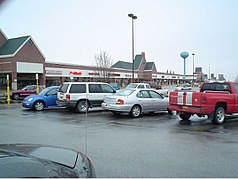Outlet store
This article needs additional citations for verification. (March 2020) |

An outlet store, factory outlet or factory store is a brick and mortar or online store where manufacturers sell their merchandise directly to the public. Products at outlet stores are usually sold at reduced prices compared to regular stores due to being overstock, closeout, returned, factory seconds, or lower-quality versions manufactured specifically for outlets. Traditionally, a factory outlet was a store attached to a factory or warehouse, sometimes allowing customers to watch the production process, such as in the original L.L. Bean store. In modern usage, outlet stores are typically manufacturer-branded stores such as Gap or Bon Worth grouped together in outlet malls. The invention of the factory outlet store is often credited to Harold Alfond, founder of the Dexter Shoe Company.[1]
History
[edit]
Outlets first appeared in the eastern United States in the 1930s. Factory stores started to offer damaged or excess goods to employees at a low price. After some time, the audience expanded to include non-employees.[2] In 1936, Anderson-Little (a men's clothing brand) opened an outlet store independent of its existing factories. Until the 1970s, the primary purpose of outlet stores was to dispose of excess or damaged goods.[citation needed]
In 1970, Vanity Fair opened the first multi-store factory outlet center in Reading, Pennsylvania.[3] Outlet stores enabled manufacturers to directly enter the retail field themselves and capture more of the profit associated with their brand names.[3] Very few outlet centers were built within major cities, in order to minimize disruption to manufacturers' existing relationships with department stores and other chain stores which had traditionally sold their merchandise.[3] To avoid "retaliation" against manufacturers from such retailers, outlet centers were often positioned at least 20 to 30 miles from the nearest department store, along major highways between metropolitan areas or in resort or recreational areas.[3]
Throughout the 1980s and 1990s, outlet centers grew rapidly in the United States. A typical outlet center in the U.S. is opened with between 100,000 and 200,000 square feet (about 1 to 2 hectares) of retail space. This can gradually increase to 500,000 to 600,000 feet (around 5 hectares). The average outlet center has an area of 216,000 square feet.[2] In 2003, outlet malls in the U.S. generated $15 billion in revenue from 260 stores.
The number of U.S. outlet centers increased from 113 in 1988 to 276 in 1991 and to 325 in 1997.[2]
Outlet malls are not an exclusively American phenomenon. In Canada, the Dixie Outlet Mall dates from the late 1980s, and was followed by Vaughan Mills in 1999, and Toronto Premium Outlets in 2013. In Europe, retailer BAA McArthurGlen has opened 13 malls with over 1,200 stores and 3 million square feet (about 30 hectares) of retail space; describing itself as an "outlet village", Bicester Village, on the edge of the town of Bicester in Oxfordshire in England, is a regular stop for bus-tours of foreign tourists, especially from China. Stores have also been emerging in Japan since the mid to late 1990s.[2]
Difference between outlet and regular stores
[edit]A majority of the products sold by clothing and accessory manufacturers at outlet stores are specifically manufactured for outlets using lower-quality materials and manufacturing processes than their higher-priced products sold in regular stores.[4][5] Tags may list a "Compare At" or "Comparable Value" price which indicates the outlet retailer's estimated full price of similar products at regular stores, but in many cases the specific product has never been available at that higher price point.[6][7]
Outlet stores often have more stringent return policies than regular stores, and manufacturers will typically not allow returns or exchanges for products purchased at outlets stores at their regular stores.[8]
References
[edit]- ^ Pérez-Peña, Richard (2007-11-17). "Harold Alfond, Donor and Shoe Factory Owner, Dies at 93". The New York Times. ISSN 0362-4331. Retrieved 2021-09-12.
- ^ a b c d "A Survey of Outlet Mall Retailing: Past, Present and Future". insead.edu. Archived from the original on 2016-03-03. Retrieved 2012-06-15.
- ^ a b c d Hartshorn, Truman Asa (1992). Interpreting the City: An Urban Geography (2nd ed.). New York: John Wiley & Sons. p. 374. ISBN 978-0-471-88750-8. Retrieved 25 July 2023.
- ^ Chao, Mary. "Q&A: The differences between an outlet and mall store". Democrat and Chronicle. Retrieved 2023-01-22.
- ^ "Retail vs. outlet store: Can you tell which outfit costs more?". TODAY.com. Retrieved 2023-01-22.
- ^ "FAQ". CoachOutlet.com. Retrieved September 30, 2024.
The Comparable Value is an indication of value based on the quality of the material used, our commitment to craftsmanship and the high standards demanded by Coach and initial prices charged for similar products in the market. The Comparable Value is not intended to be a representation of a sale or of savings versus any particular product on a particular day.
- ^ Wisoff, Brandon (January 2019). "The Price is Not Right: Class Action Risks of Comparative Price Advertising" (PDF). Retrieved September 30, 2024.
- ^ "Outlet shopping: The deal is in the details". Consumer Advice. 2019-07-10. Retrieved 2023-01-22.
